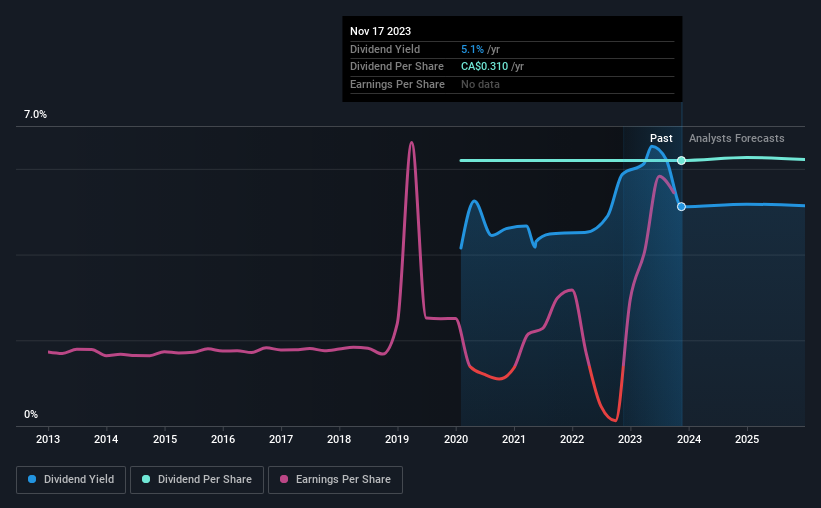Is It Smart To Buy Sagicor Financial Company Ltd. (TSE:SFC) Before It Goes Ex-Dividend?
Readers hoping to buy Sagicor Financial Company Ltd. (TSE:SFC) for its dividend will need to make their move shortly, as the stock is about to trade ex-dividend. The ex-dividend date is one business day before the record date, which is the cut-off date for shareholders to be present on the company's books to be eligible for a dividend payment. The ex-dividend date is important because any transaction on a stock needs to have been settled before the record date in order to be eligible for a dividend. Thus, you can purchase Sagicor Financial's shares before the 21st of November in order to receive the dividend, which the company will pay on the 13th of December.
The company's next dividend payment will be US$0.056 per share, and in the last 12 months, the company paid a total of US$0.23 per share. Based on the last year's worth of payments, Sagicor Financial has a trailing yield of 5.1% on the current stock price of CA$6.05. If you buy this business for its dividend, you should have an idea of whether Sagicor Financial's dividend is reliable and sustainable. So we need to investigate whether Sagicor Financial can afford its dividend, and if the dividend could grow.
See our latest analysis for Sagicor Financial
Dividends are typically paid from company earnings. If a company pays more in dividends than it earned in profit, then the dividend could be unsustainable. Sagicor Financial has a low and conservative payout ratio of just 2.7% of its income after tax.
Companies that pay out less in dividends than they earn in profits generally have more sustainable dividends. The lower the payout ratio, the more wiggle room the business has before it could be forced to cut the dividend.
Click here to see the company's payout ratio, plus analyst estimates of its future dividends.
Have Earnings And Dividends Been Growing?
Companies with consistently growing earnings per share generally make the best dividend stocks, as they usually find it easier to grow dividends per share. If earnings decline and the company is forced to cut its dividend, investors could watch the value of their investment go up in smoke. That's why it's comforting to see Sagicor Financial's earnings have been skyrocketing, up 59% per annum for the past five years.
Many investors will assess a company's dividend performance by evaluating how much the dividend payments have changed over time. Sagicor Financial's dividend payments are effectively flat on where they were four years ago.
The Bottom Line
From a dividend perspective, should investors buy or avoid Sagicor Financial? Typically, companies that are growing rapidly and paying out a low fraction of earnings are keeping the profits for reinvestment in the business. This strategy can add significant value to shareholders over the long term - as long as it's done without issuing too many new shares. Overall, Sagicor Financial looks like a promising dividend stock in this analysis, and we think it would be worth investigating further.
In light of that, while Sagicor Financial has an appealing dividend, it's worth knowing the risks involved with this stock. Be aware that Sagicor Financial is showing 2 warning signs in our investment analysis, and 1 of those shouldn't be ignored...
Generally, we wouldn't recommend just buying the first dividend stock you see. Here's a curated list of interesting stocks that are strong dividend payers.
Have feedback on this article? Concerned about the content? Get in touch with us directly. Alternatively, email editorial-team (at) simplywallst.com.
This article by Simply Wall St is general in nature. We provide commentary based on historical data and analyst forecasts only using an unbiased methodology and our articles are not intended to be financial advice. It does not constitute a recommendation to buy or sell any stock, and does not take account of your objectives, or your financial situation. We aim to bring you long-term focused analysis driven by fundamental data. Note that our analysis may not factor in the latest price-sensitive company announcements or qualitative material. Simply Wall St has no position in any stocks mentioned.

